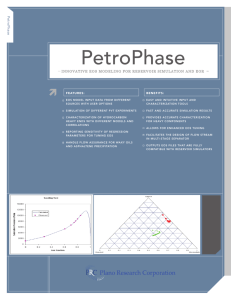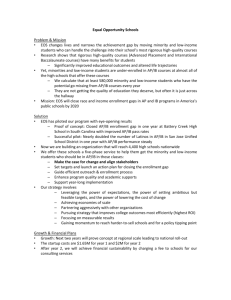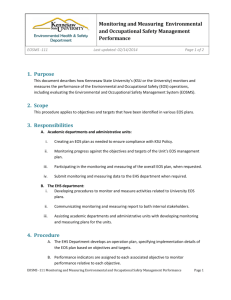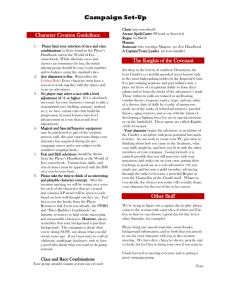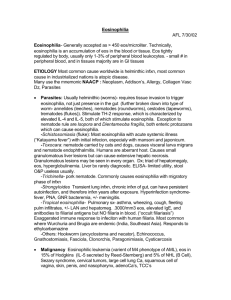Part 4, Strength
advertisement
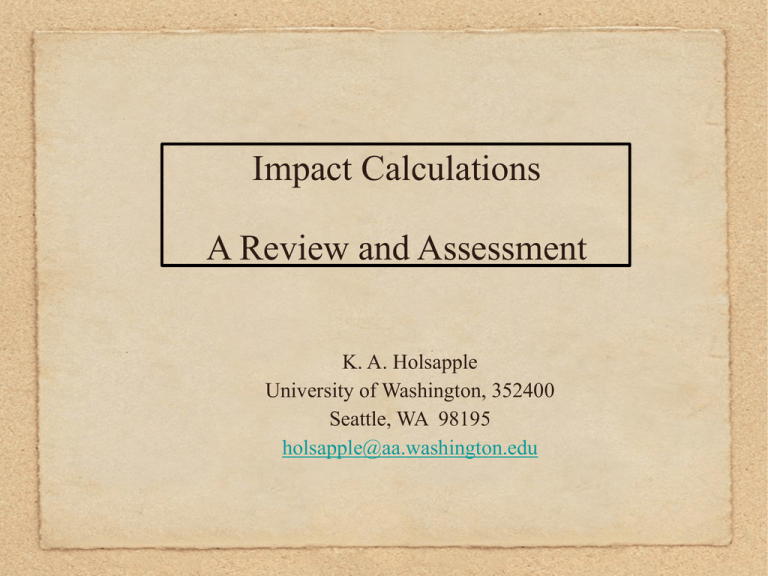
Impact Calculations A Review and Assessment K. A. Holsapple University of Washington, 352400 Seattle, WA 98195 holsapple@aa.washington.edu Part 1: Introduction Rocks: A Modeling Challenge Part 1: Introduction The modeling of material behavior is the biggest shortcoming in code calculations, and the primary reason for bad results.. Part 1: Introduction What I won’t talk about, but are important: Eulerian v. Lagangian codes Handling Mixtures in Eulerian codes Boundaries in Eulerian codes Grid distortion in Lagrangian N-body codes: Limited material behavior: simple coefficient of restitution Large-scale macro-porosity: cannot smear into a continuum Part 1: Introduction Energy Limit Water Wet sand and rocks Dry Sand But, there is lots of data, and it is consistent if organized in appropriate ways.. Part 1: Introduction QuickTime™ and a DV/DVCPRO - NTSC decompressor are needed to see this picture. And, while much of it is for explosions, Impacts and Explosions are (almost) the same… Part 1: Introduction QuickTime™ and a GIF decompressor are needed to see this picture. The Siren of CPU Power! Part 1: Introduction Understanding the processes: Regions of Impact Processes 1. r ~0-> a: Coupling of the energy and momentum of the impactor into the asteroid 2. r ~ a -> 2a: Transition into point source solution, shock breakaway. 3a. r ~ 2a -> : Shock decays with distance, strength (and gravity) become important 3b. r ~ 5a -> 15a: Crater boundary, depending on problem Part 1: Introduction What do we need? Balance Laws (easy: continuum mechanics: balance of mass, momentum, energy) Material behavior (very hard: 100 Mbar down to partial bars!) Robust computer codes Part 1: Introduction Material Behavior: Three regimes EOS Single species EOS Single species EOS e(P, r) e(P, r) P>>r c2 Mixture Theory (including porosity) Solids Flow, fractur e, failure P~r c2 Stress-Strain Equations Yield Flow & Failure Fracture P<<r c2 Yield surface, Flow rule Fracture Criteria Part 2: Source region, EOS Region 1: Source Coupling Other Names: Penetration region Contact and Compression region Coupling region Early-time region Isobaric Core region Characteristics •High Pressure >> c^2 • => Hydrodynamic • => Primarily determined by EOS In this regime, the energy and momentum of the impactor are transferred into the target. This is the bailiwick of the EOS.. EOS Single species EOS Single species EOS e(P, r) e(P, r) Mixture Theory (including porosity) P>>r c2 Part 2: Source region, EOS It is the EOS that determines the initial high-pressure response, including: The Maximum Initial Pressure The Transition into the Point-Source field The exponent m of that point source The source effect on all subsequent scaling Part 2: Source region, EOS Stress Waves: Pressure Decay PROPERTIES: 1. Max Pressure=r0[(c0 /2) U+(s/4)U2] 2. Transition to a Point-Source Solution 3. If P>>r0c2, The Point-Source is SelfSimilar and Power-Law 4. But every impact velocity case approaches a PointSource Solution (but not self-similar) Part 2: Source region, EOS And, pressure decay is problem dependent: Pressures decay much faster in a porous material, the point source has m~1/3, P~r-6 Part 2: Source region, EOS Point-Source Impacts Initially, the flow field depends on all three of the impactor measures: radius a, velocity U and mass density r However, soon all signatures of those disappear, and there remains but a single measure of the impactor: aUmdn Then all aspects of the process can depend only on aUmdn and not separately on the three measures.. Part 2: Source region, EOS Scaled Pressure Decay Scaled Pressure Decay Assuming a Point-Source 100 run 101 U=80 km/s run 101b U=40 km/s run 101a U=20 km/s Self Similar Scaled Pressure=P/(rc2) 10 Point-Source, Selfsimilar regime All Velocity Cases in a given material approach the same Point-Source Solution after a few impactor radii 1 Point-Source, NotSelf-Similar 0.1 0.01 0.1 1 10 Scaled Range=(r/a)(c/U) m 100 Thus, there is no signature of the impact velocity except in the source region r<2a Part 2: Source region, EOS EOS => EOS Different sources have the same farfield results whenever the point-source property holds! The EOS determines the EOS: The Equation Of State determines Equivalence Of Sources Part 2: Source region, EOS “Equivalent” Sources: mass x 0.82 Q U=5 km/s U=30 km/s Depends on: U=50 km/s Mass=1010 kg Mass=5 108 kg Mass=2.2 108 kg TNT Q=4.2 1010 Mass=2.4 1010 (24 Mtons) Part 2: Source region, EOS So, what do we need to define the EOS? ¨ 1. Equations of State for solid ¨ 2. + modified by mixtures 3. + modified by Porosity Part 2: Source region, EOS Analytical Single-phase EOS Models Murnaghan: Non-linear elastic, no thermodynamics, limited uses. Tillotson (1962): Powers in density + thermal component~E + vapor interpolation Mie-Gruneisen: Linear Us-up + thermal component~E + vapor interpolation Puff (1966): vapor Simple algebraic descriptions, no phase cha Part 2: Source region, EOS Analytical, Explicit Three-Phase Gray (1971), ESA, Philco-Ford (1969), Barnes et al. (1967 and on) Aneos (1970) solid, liquid, vapor No molecules, no mixture theory, limited solid phase changes Panda (1981+) Various combinations of cold, thermal, electron and multi-phase models Allows mixtures of molecular species, multiple phases Part 2: Source region, EOS Complete Equations of State E(r,P) (Cold+Thermal +Electron components) Part 2: Source region, EOS What properties are sometimes available for calibration?? 1.Loading along the Hugoniot from shock measurements, but usually not energy or temperature directly. U<10km/s. 2. Maybe some data on adiabats from shock unloading. 3. Static melt and vapor points at atmospheric pressure. 4. Other data at one bar such as specific heat, thermal expansion. 5. The critical point. Part 2: Source region, EOS Porosity Addition..solid + voids Herrmann’s P-alpha (1969) Carroll-Holt (1972) Seaman and Linde POREQST (1969) Holt et al. (1971) Part 2: Source region, EOS Herrmann’s P-alpha Distension ratio a=rsolid/rtotal Ps ranges from r0 (initial) to (fully crushed) A crush curve defines crushing: decrease of the void volume: a=f(P,Pe,Ps) Instantaneous state variable P(r, T,a)= Psolid(rsolid,T)/a e(r,T,a)= esolid(rsolid,T) Pe Part 2: Source region, EOS 4 Pure #75 sand 36% 70% 3.5 Loose #75 sand Dense #75 sand 45% Distension, alpha Crush curves for porous Sands: Crush begins at Pe, complete at Ps 57% 3 45% Coarse Sand 2.5 2 1.5 1 1.00E+06 1.00E+07 1.00E+08 1.00E+09 1.00E+10 Pressure (From Kevin Housen) Part 2: Source region, EOS Pure #75 sand 36% 4 Crush is limited to one decade! 57% Loose #75 sand 3.5 Dense #75 sand 45% Distension, alpha The P-Alpha model Pe=1e7 Ps=2e9: 70% 45% 3 Coarse Sand P-Alpha Model 2.5 2 1.5 1 1.00E+06 1.00E+07 1.00E+08 1.00E+09 1.00E+10 Pressure You don’t always get what you think!! Part 2: Source region, EOS Furthermor e: The actual path followed in CTH with Ps=20 mpa You don’t always get even what you think you didn’t get!! QuickTime™ and a TIFF (Uncompressed) decompressor are needed to see this picture. P=85 mpa Part 2: Source region, EOS Finally, supposing we have a reasonable EOS, how do we use it in Wave Codes? Direct analytical evaluation, or.. Tabular Data Tables (Sesame) We have Sesame tables from Panda, Aneos, Seslan (Los Alamos) and others Part 2: Source region, EOS Summary of EOS The model choice will fix the scaling and other important features of a solution The tools are there for complex models, but it is very hard to get the data to calibrate the models, even for “simple” ones like Aneos (24 constants) I think many users are unaware of the major uncertainties: the very existence of a pre-existing model gives it unwarranted credibility It is Extremely complex to construct a multiplespecies model using Panda. Part 2: Source region, EOS But wait, there’s more… Porosity adds yet another large uncertainty Phase changes Kinetic Effects Multiple Species And all of that assumes we know the actual material, which we don’t in most or our applications! Part 3, Stress-Strain Stress-Strain EOS Single species EOS Single species EOS e(P, r) e(P, r) Mixture Theory P>>r c2 (including porosity) Solids Stress-Strain Equations P~r c2 Part 3, Stress-Strain Stress-Strain behavior • When P≈rc2 the material no longer behaves as a fluid. • Then we need a constitutive equation for the stress-strain behavior • Almost always, in wave codes that is simply an isotropic linear elastic relation (which is undoubtedly extremely crude). Part 4, Strength Which brings us to the strength parts.. EOS Single species EOS Single species EOS e(P, r) e(P, r) P>>r c2 Mixture Theory (including porosity) Solids Flow, fractur e, failure P~r c2 Stress-Strain Equations Yield Flow & Failure Fracture P<<r c2 Yield surface, Flow rule Fracture Criteria Part 4, Strength The “F” words: Flow, Fracture and Failure Models for these fall into three groups: • “Degraded Stiffness”, no explicit flow or fracture. • “Flow” including plasticity and damage, used to model microscopic voids and cracks leading to an inability to resist stress. • “Fracture”, involving actual macroscopic cracks and voids which are tracked, leading to an inability to resist stress. Part 4, Strength In a continuum theory, the first two can be included directly, the latter is difficult, unless some statistical approach is used to smear them out. Part 4, Strength Some Real Data Part 4, Strength Yield depends on pressure Cohesion Tensile strength ANGLE OF FRICTION Part 4, Strength Damage and degradation leading to ultimate failure occur at some limiting strain Part 4, Strength PressureDependent Ductility: Failure Strain depends on pressure.. Part 4, Strength Pressure Dependent Yield and Ductility Part 4, Strength Bulking: increase in volume at failure Part 4, Strength Damaged material: Cohesionless, but not Fluid. Grady Kipp, failed Part 4, Strength Tensile fracture depends strongly on strain rate Strength v. Strain Rate from Various Studies Concrete (plai n) Concrete (polyes ter) 1000 Lim esto ne (Oakhal l) Oil Sh ale (80ml /kg ) Dynamic Strength (Mpa) Codes Arkansa s Novaculite Wes terly Gran ite (Lip kin ) 100 H&H Gra nite (Crack Distri buti on) Ful ly Cracked, Larg e (Vari ous Ma teria ls) Melos h et al. (Basa lt) Dresse r Basa lt 10 1.E+00 1.E+01 1.E+02 1.E+03 1.E+04 Strain Rate (1/sec) 1.E+05 1.E+06 1.E+07 Benz a nd Aspha ug, 199 4 Part 4, Strength Flow and Fracture Models should include: Strength v. Strain Rate from Various Studies Concrete (plai n) Concrete (polyes ter) 1000 Lim esto ne (Oakhal l) Dynamic Strength (Mpa) Oil Sh ale (80ml /kg ) Arkansa s Novaculite Wes terly Gran ite (Lip kin ) 100 H&H Gra nite (Crack Distri buti on) Ful ly Cracked, Larg e (Vari ous Ma teria ls) Melos h et al. (Basa lt) Dresse r Basa lt 10 1.E+00 1.E+01 1.E+02 1.E+03 1.E+04 1.E+05 1.E+06 1.E+07 Benz a nd Aspha ug, 199 4 Strain Rate (1/sec) ••Degradation •Pressure Pressure dependent with especially strain failure Yield over envelope envelope (damage) and even Permanent when fullystrains failed •Rate dependent, ductility: infailure Failure tension strain increases with pressure Part 4, Strength We can do all of that using: •An Explicit Yield Envelope •Envelope is pressure dependent •A damage measure •Envelope changes with damage •Damage accumulation depends on pressure Part 4, Strength Flow and Fracture: Yielding and Cracking Lets put it all together; Start with the yield envelope: Initial Yield=F(stresses) or G(strains) •Isotropic=> s1, s2, s3 (Or three stress invariants) •Commonly only 2, e.g. J2=F(P) Or max shear=f(pressure) Part 4, Strength Special Case: VonMises (metals) Shear Stress Pressure Part 4, Strength Special Case: Mohr-Coloumb & Drucker-Prager Shear Stress Tan( ) Uniaxial Compressive Strength Cohesion Uniaxial Tensile Strength Pressure Part 4, Strength Mohr-Coloumb with Mises Cutoff: Part 4, Strength Yield Functions in ShearPressure Space Mises Cutoff Crush Friction Angle Tensile Strength Compressive Strength Shear Stress cohesion Pressure Part 4, Strength Now add Improvements: •A Damage measure. e.g. accumulated plastic strain or plastic work •Then the envelope degrades with damage •Damage accumulates slower at higher pressure leading to more ductility at higher pressure •The envelopes also depend on rate, mostly the tension parts •And they depend on temperature Part 4, Strength An example that has many of these is that of Johnson & Holmquist, 1990 depends on rate Yield Envelope =0 ge a m da static interpolate with damage depends on rate d e= g a am 1 static Pressure Part 4, Strength But, Improvements Needed Temperature dependence Tensile point depending most strongly on rate General EOS, not just non-thermo algebraic Porosity Interdependence between porosity, strength Size Dependence Part 4, Strength Stress Another approach is to use Stiffness Degradation rather than an explicit yield envelope (e.g. Grady-Kipp Damage Model) Modulus E(strain) Strain Part 4, Strength The Grady-Kipp Model Special nature It is a Tensile Brittle Fracture Mechanism For fragmentation in mining One-Dimensional Model Synthesized for constant strain rate histories only Governed by Crack Distributions (Weibull) and growth Implies rate and size-dependent strength But Attractive Physics Part 4, Strength A Grady Kipp Implementation in 3D •Damage is isotropic, so that when a crack is formed in one directions, all directions lose stiffness •As damage accumulates, the stiffness in both tension and in shear decrease, eventually to zero. •Therefore, material failed by the outgoing shock behaves as water. •Calibrated to disruption test, by adjusting the strength parameters •But, for cratering, craters are way too large! Part 4, Strength The Grady-Kipp Approach Shear Da m ag e Af fe ct Shear stress at a given shear strain Tensile stress at a given tensile strain Fully damaged material Pressure Part 4, Strength So how can we improve the models? Compare, Compare, Compare to real experiments Large explosive field tests Carefully controlled lab tests to impact craters (but what was the impactor?) Test, Test, Test real materials Crushability Strength in different states Part 5, Concluding Remarks Current Shortcomings: • Damage is a scalar: not directional • Behavior is isotropic, even after damage • Most strength models do not address all types of “strength • Codes often have “hidden features” • Even the limited models available usually greatly surpass • We do not often enough make comparisons to any experi Part 5, Concluding Remarks We are too anxious to “get results and publish” • for the crater “X” on the moon “Y” of planet • “Z”, • and do not make enough effort of developing and • checking the codes and models • Part 5, Concluding Remarks etc We cannot model well enough to distinguish details for a particular crater We cannot handle mixtures well We don’t have a good handle on even the mechanisms that give very significant features: e.g. late-stage adjustments. Mixing rocks and atmospheres, and porosity makes for very difficult code calculations We do primarily continuum mechanics, and cannot distinguish individual particles, size distributions, ejecta particle characteristics and fate We don’t do chemistry Part 5, Concluding Remarks QuickTime™ and a Photo - JPEG decompressor are needed to see this picture. Impact into a porous target Part 5, Concluding Remarks QuickTime™ and a Animation decompressor are needed to see this picture. Porous cratering: Marker particles Part 5, Concluding Remarks QuickTime™ and a Photo - JPEG decompressor are needed to see this picture. Impact into water Part 5, Concluding Remarks Summary We have a long way to go Calculations should be considered order of magnitude at best: Computer power will not save us and might even be detrimental. Part 5, Concluding Remarks “On top of this, we observed that the current exponential increase in computer power is already leading to grave difficulties in assessing the content of simulations of complex phenomena, as well as comparing them with high quality experimental data. Among other challenges, this situation leads to the erroneous possibility of thinking that because output is complex, we must be successfully modeling complex phenomena.” T. G. Trucano, “Prediction and uncertainty in computational modeling of complex Phenomena: A whitepaper. SAND98-2776, 1998 Part 5, Concluding Remarks However: We have learned a lot, especially qualitative, of cratering mechanics from codes. Cratering regimes: strength, gravity, porous Ejecta transport and emplacement Effects of oblique impacts Thermodynamic histories of material Late-stage readjustments: Scope, although not mechanism. Calibration to real results, followed by minor extrapolations are probably effective. Part 5, Concluding Remarks And, some recent advances are promising: Beginnings of all appropriate rock strength features: Damage, bulking, thermal, strain softening E.g. O’Keefe et al, 2001, Holsapple and Housen, 2002 Mixed materials Assuming non-equilibrium thermal (O’Keefe et al. 2001 and others) Assuming phase equilibrium (Ivanov, 2003) Atmospheric transport e.g. Artemieva & Pierazzo (2003) Part 5, Concluding Remarks I believe it is the correct modeling of the down-side of the Stress-strain curves that we have not done well, and that is the key to important aspects such as latestage readjustments. Part 6, The End THE END, Thank You


